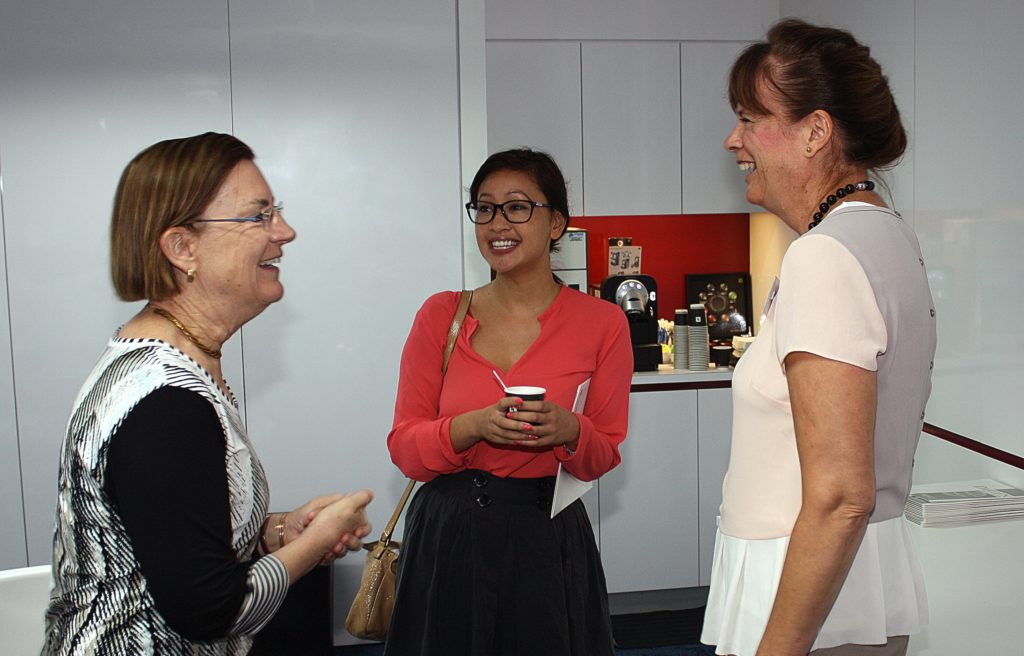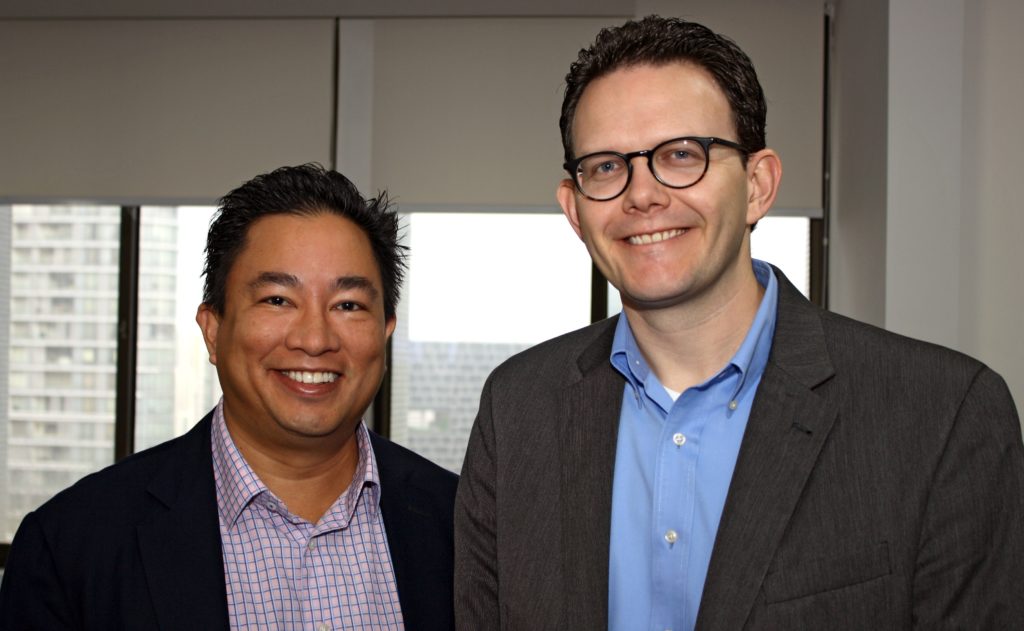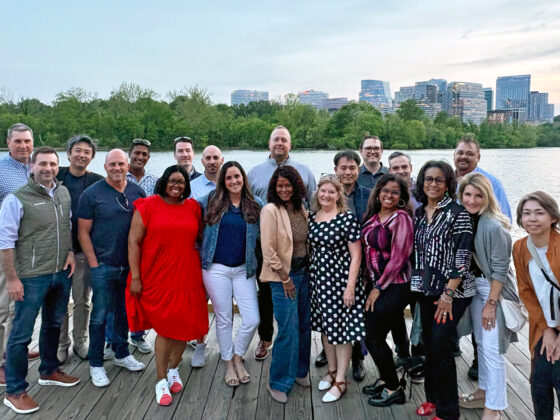On Friday, 7 October in Singapore, design thinking and innovation expert Jeanne Liedtka shared insights on design thinking from her own research, from her work with various types of organizations, and from participants in her courses. Attendees at the event represented large companies, multinationals, family-owned businesses, non-profits, and consultants from several industries, including manufacturing and industrial, education, financial, healthcare and more. Many of the participants had previously taken Jeanne’s Design Thinking MOOC on Coursera or courses in her Design Thinking Specialization at Darden Online.
Jeanne’s material focused on the “why” of design thinking, the mindsets and philosophies the process helps to overcome, and the “what,” some actual cases she has worked on, their outcomes, and how they were able to achieve success. She uncovered the elements of a good strategy, which has to consider possibilities, be realistic about constraints, and deal with uncertainties. And she exhorted the group to focus with clarity on their “job to get done,” not to start with constraints, because this approach often prevents true innovation. She shared the results of many years of research into the barriers to innovation and what is different in individuals and organizations that have been successful at creating innovation.
It is not surprising that this was the area of most interest to the program attendees: how to create the correct culture and environment for success of innovation through design thinking in their own organizations. The following questions (accompanied by Jeanne’s responses) were asked by participants during the program and seem to be emblematic of the types of issues organizations in Asia have in actually implementing a design thinking process.
Q: How do you increase the speed of innovation?
A: Run projects with small, intact teams. It’s hard for large teams to accomplish anything very quickly. What seems to work in other organizations is to build this small core team and then build into the flow a process that invites broader stakeholders into the conversation and builds engagement, commitment and alignment with the larger group. The other thing to keep in mind is that strategy conversations always end up being about change management and paying attention to the human factor. Get people to take small bets initially, which makes it easier to get organizations on board for the bigger innovations.
Q: Speaking of small bets, the design thinking examples we hear seem to be about big bets. How do you get people inspired about small ideas?
A: First, a qualification: we don’t know how big an idea is until we test it. We tend to dismiss anything new because we don’t believe it will be big. The dilemma with the “big” ideas is what do the rest of us impact? Stephen Covey talks about our areas of control and influence, so that’s a good way to think about it. We tell people that giant disruptive change is important, but most people can’t impact that type of change, which leaves most of us with no role in innovation. This is why when we started to focus on quality post-world-war, it resulted in this Total Quality Management (TQM) process that allowed everyone in the organization to focus on quality, but big, messy issues still required the experts. Similarly, in order to be competitive in the future, innovation has to be everyone’s job. It’s a different job at different levels of the organization, but there are more people at the bottom of the pyramid; focusing only at the top causes us to miss big opportunities. Innovation should be about improving the experience of people we serve, and then novelty becomes less important. Inviting everyone into the process creates new value that we might otherwise miss.
Q: What are the steps to catalyze culture change, to really get it moving, and what are the steps to keep it going?
A: Design thinking benefits from starting both bottom-up and top-down at once; inviting everyone who wants to be an innovator, not forcing everyone to go to a class. Once results start to show, others will want to participate. Give people permission to try, give them the freedom to have experiences. They have to be able to talk to customers to engage in design thinking. The quality of originality of ideas will suffer if people don’t have access to customers. Intuit brings customers into their cafeteria for two hours every week so managers can seek them out and talk with them. Make customers accessible, make training available, start with the people who want to do it, invest in some quick wins. Asking permission slows you down. From the top down, support the rest of the organization with the structural things they need to act. You have to have a cultural that will allow failure, which will require some change in most organizations. Celebrating mistakes has to be very baked into your culture. That’s not going to be an easy thing. It goes against what most organizations reward.
Q: How do you approach the subject of innovation for companies that value things like tradition and reliability? Innovation can be very uncomfortable to these types of organizations and can feel like a threat.
A: Don’t tackle theoretical debates. Don’t make design thinking a religion or argue why design thinking is superior. Approach it in whatever way you need to do it to have productive conversations. Some companies that have been successful have called it something else. A good strategy is to tap into existing values for that organization. For example, engineering organizations are more interested in a testing process. This is comfortable for engineers who like the idea of testing and improving, so lead with that. Locate a set of things people care about where there’s a need and start there, rather than saying “let’s take on tradition.” “Democratizing innovation” might not be good language for those organizations. You have to have a deep understanding of how that organization sees the world and what their job is to get done, and then tailor your message to people you’re targeting.
Q: Are we more creative today than 100 years ago? Are we a more innovative society?
A: It depends on what motivates you, what makes you feel optimistic about innovating. Maybe innovation historians would agree that we were more innovative in the past, but the pace of change in today’s world is real: barriers to trade, increased access to markets – all are creating change challenges for orgs to deal with, even if some of these developments don’t represent fundamental change.
Q: Why would you recommend design thinking over another innovation methodology, such as lean startup?
A: In actuality, all these different approaches, lean, agile, design thinking, they all have more in common than not. Which methodology you choose is less important than the basic philosophy of starting with the customer and keeping their experience at the center of your initiative.
We greatly appreciate the assistance of our hosts, the American Chamber of Commerce in Singapore and Judith Fergin, the Darden Singapore Alumni Chapter Presidents, Richard Loh (MBA ’96) and Matt Aujla (MBA ’01), and Larenda Mielke, Senior Director of Executive Education. Without them, this event would not have been possible.


If you’re interested in one of Jeanne’s courses in Design Thinking, read more about the specialization and individual programs.
To inquire about any of our programs, please contact us at Darden_ExEd@darden.virginia.edu or 434-924-3000.





